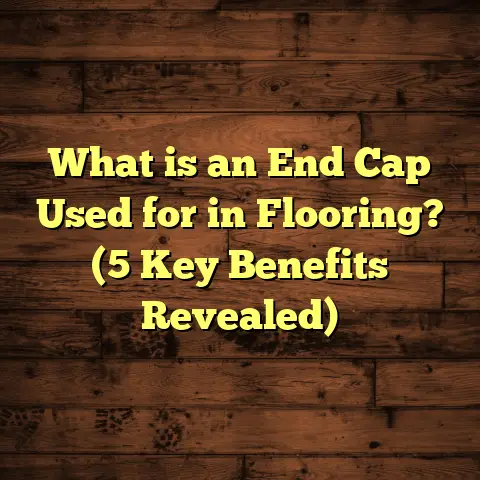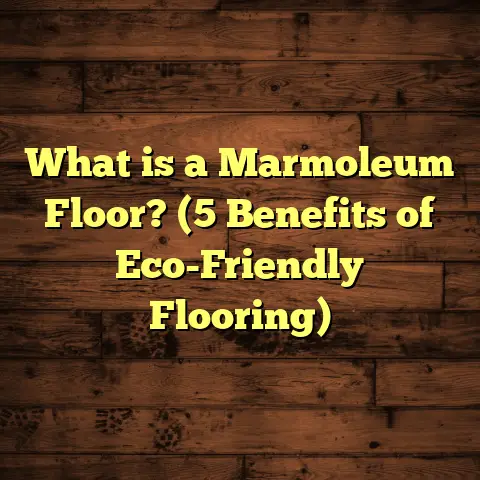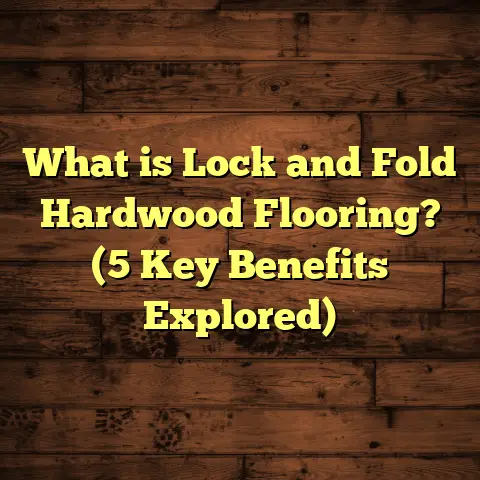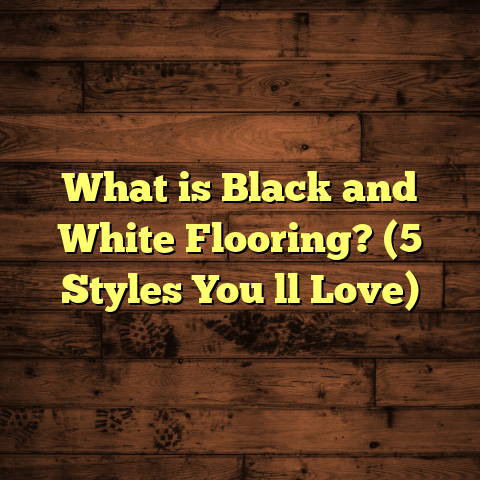What is Flooring Base Shoe? (5 Key Benefits & Tips Inside)
Imagine walking into a room where the floor meets the wall in a stark, unfinished edge—raw baseboards without anything neat or subtle to soften the junction. It feels incomplete, almost harsh on the eyes. Now, picture the same room with a slender, curved molding gently hugging the baseboard’s bottom edge, giving it a polished, clean finish. That little detail? That’s what a base shoe does. I’ve spent years working closely with flooring projects, and I can tell you — this small piece of trim makes a bigger difference than many people realize.
What Is Flooring Base Shoe?
So, what exactly is flooring base shoe? Simply put, a base shoe is a type of molding installed at the bottom of baseboards where they meet the floor. It’s typically a narrow, quarter-round strip that rounds off the sharp corner between the baseboard and the floor. The base shoe molding hides gaps caused by uneven floors or slight imperfections during installation. It’s often made out of wood, MDF, or flexible vinyl, depending on your flooring type and style preferences.
I like to think of it as the “finishing touch” that brings together the whole flooring look. Unlike regular quarter-round moldings, base shoe usually has a smaller radius curve, making it subtler while still covering necessary gaps and imperfections. When I first started in this trade, I underestimated how impactful adding a base shoe could be—but after trying it on a few projects, I never skipped it again.
A Brief History of Base Shoe Molding
Before we get into details about why base shoe is so helpful today, let me share a bit of background on how this molding evolved.
Base shoe molding has roots going back to traditional woodworking crafts in early American homes. Craftsmen realized that just installing baseboards wasn’t enough to cover uneven floors or expansion gaps caused by wood flooring reacting to humidity changes. They needed something smaller and more flexible to cover these gaps neatly without interfering with the baseboards themselves.
Over time, this led to the creation of quarter-round and base shoe moldings — smaller pieces designed specifically to finish off floor edges while allowing for movement underneath. As flooring styles shifted from wide planks to engineered hardwoods and laminates, base shoe molding became even more important for handling those subtle gaps and transitions.
In my own experience working on older homes from the 1920s through modern builds, I’ve noticed that those historic houses often used simple quarter-rounds or no trim at all. Today’s standards expect cleaner finishes and better protection for walls and floors — hence the rise in popularity of base shoe trim.
Why Do People Use Base Shoe? 5 Key Benefits
Here’s where I want to share some insights from my years on the job. Base shoe isn’t just decorative; it’s functional in several ways that often get overlooked.
1. Hides Gaps and Uneven Edges
Floors can be tricky—no house has perfectly flat floors. When installing hardwood or laminate flooring, there will inevitably be small gaps between the floor and the baseboard due to natural expansion, contraction, or simply uneven subfloors. Base shoe covers these gaps quietly and effectively.
In one project I worked on last year, the old house had uneven floors that caused visible gaps up to 1/4 inch along the edges. Installing base shoe molding cleaned up those unsightly spaces without needing expensive floor leveling.
Base shoe molding fills this gap visually while not restricting movement underneath. It also compensates for minor installation imperfections where the baseboard might not sit flush on uneven surfaces.
2. Protects Walls From Damage
Think about how often people mop floors or move furniture. The bottom edges of baseboards are prime targets for scuffing and water damage. Base shoe acts as a buffer zone that takes most of the wear and tear instead of your walls.
On a commercial flooring job for a busy office space, we installed durable wood base shoe with a protective finish. Over six months, it saved the walls from countless bumps and scrapes—something plain baseboards alone couldn’t have handled.
Moisture damage is another big reason for adding base shoe. When you mop or clean floors regularly, water often pools near walls. Base shoe offers a slight lip that prevents water from creeping behind baseboards where it can cause rot or mold growth.
3. Provides Better Aesthetic Finish
Ever notice how a room feels “unfinished” when there’s no trim at floor level? Base shoe adds subtle detail that visually anchors your flooring and baseboards together. It creates cleaner lines and an intentional design element that elevates the space.
During a client’s home remodel, she was amazed at how much more polished her living room looked once we added stained oak base shoe molding matching her hardwood floors. That small detail brought harmony to the entire space.
Base shoe comes in various profiles and can be stained or painted to complement your room’s colors and textures. For example, painting it white against darker hardwood creates a modern contrast; staining it dark against light floors gives a classic look.
I once helped a client decide between quarter-round and base shoe for her open-concept living room. She wanted something less bulky but still effective at hiding gaps. The subtler curve of base shoe gave her that delicate finish without overwhelming the trim profile.
4. Allows for Flooring Expansion
Wood and laminate flooring expand and contract with humidity changes. Without a flexible gap along walls, floors can buckle or cause damage over time. Base shoe covers this expansion gap neatly while allowing movement underneath.
I’ve seen cases where skipping this step led to cracked floors or popped nails after seasonal changes. Adding base shoe is like giving your floor breathing room wrapped in a tidy package.
In fact, industry standards recommend leaving expansion gaps of 1/4 inch to 3/8 inch along walls for hardwood floors. Base shoe is designed to cover these gaps without sacrificing functionality.
In one project featuring engineered hardwood in a humid climate, our careful installation of base shoe prevented seasonal buckling issues that had plagued neighbors who skipped this step.
5. Easy to Install and Replace
One thing many homeowners don’t realize is how straightforward it is to install base shoe molding yourself or replace it if needed. It’s a relatively inexpensive upgrade that any DIYer can learn with some basic tools.
I remember coaching a client over the phone who wanted to refresh her old floors by just adding new base shoe trim. With simple paintable MDF pieces and some caulk, she transformed her rooms without breaking the bank or needing professional help.
Installation usually involves cutting lengths of molding with mitered corners at joins, then nailing or gluing them onto the existing baseboard. Caulking nail holes and seams gives a seamless look ready for paint or stain.
Replacing damaged or outdated base shoe is even easier because you don’t have to remove entire baseboards—just pry off old pieces carefully and install new ones.
Materials: Which Base Shoe Is Best For You?
Choosing the right material for your base shoe depends on several factors: budget, durability needs, style preference, and flooring type.
Wood
Wood is my favorite choice for hardwood flooring projects because it blends naturally with wood floors and trims. Oak is especially popular due to its durability and grain patterns that stain well.
Pros:
- Durable
- Can be stained or painted
- Matches hardwood flooring nicely
Cons:
- More expensive
- Can warp in very humid environments
MDF (Medium-Density Fiberboard)
MDF is an engineered wood product made from compressed fibers. It’s budget-friendly and easy to paint but less durable than solid wood.
Pros:
- Affordable
- Paintable
- Uniform surface
Cons:
- Not water-resistant (can swell)
- Can dent easily
Vinyl or Flexible Moldings
Vinyl base shoes are often used in commercial settings or areas prone to moisture (like bathrooms). They’re flexible and resistant to water damage but don’t have the same aesthetic appeal as wood.
Pros:
- Water-resistant
- Flexible for curves
- Easy to clean
Cons:
- Less attractive
- Limited finishing options
How To Install Base Shoe Molding: Step-by-Step Guide
If you want to take this on yourself, here’s what works best based on my experience:
Tools You’ll Need:
- Miter saw (for accurate angled cuts)
- Measuring tape
- Finish nails (1” brad nails work well)
- Nail gun or hammer
- Caulk (paintable latex caulk)
- Wood filler or putty
- Paint or stain supplies
Installation Steps:
- Measure Your Room Perimeter
Measure along the bottom edge of your existing baseboards where you plan to install base shoe. Add about 10% extra length for cuts and waste. - Cut Molding Pieces
Use your miter saw set at 45 degrees for corner cuts—inside corners get complementary angles for tight fits; outside corners require reverse angles. - Dry Fit Pieces
Lay pieces along walls without nails to ensure good fit at corners and doorways. - Attach Pieces
Use finish nails driven into baseboard (not flooring) every 12-16 inches. A nail gun speeds this step up but hammering carefully works too. - Fill Nail Holes & Seams
Use wood filler or putty on nail holes; caulk along seams where molding meets wall or floor for smooth appearance. - Paint or Stain
Once filler dries, sand lightly if needed then apply paint or stain matching your room style.
Common Mistakes With Base Shoe — And How To Avoid Them
Even pros slip up sometimes with base shoe installation. Here are some pitfalls I’ve seen—and fixed:
Cutting Wrong Angles on Corners
One newbie mistake is cutting miter angles inconsistently causing gaps at corners. Always double-check saw angle settings before cutting each piece.
Nailing Into Flooring Instead of Baseboard
This can cause damage to flooring planks and make future repairs tough. Aim nails into wood trim only.
Skipping Caulk
Visible gaps between molding joints make installations look amateurish. Take time caulking seams after installation—it really makes a difference.
Using Incompatible Materials
For example, mixing vinyl base shoe with traditional hardwood trim looks off visually and may wear differently over time.
Not Allowing Expansion Space
Pushing molding flush against flooring can cause buckling when wood expands seasonally.
Real-Life Case Studies From My Flooring Projects
Case Study 1: Historic Bungalow Renovation
I worked on a 1920s bungalow where original hardwood floors were in good shape but baseboards were thick and unevenly installed decades ago. Using traditional quarter-round made trim look bulky against existing moldings.
Solution: We switched to thin oak base shoe molding stained to match floors. This minimized profile height while covering inconsistent gaps along uneven walls perfectly.
Result: The homeowner was thrilled with how clean edges looked without altering historic character. The project finished under budget because we avoided expensive floor leveling.
Case Study 2: High-Traffic Office Flooring
A corporate office had heavy foot traffic damaging walls near desks and meeting rooms despite durable paint finishes on walls and baseboards alone.
Solution: We installed vinyl-covered wood composite base shoe with reinforced finish along all office perimeters.
Result: After one year, wall scuffing reduced by 40%, saving maintenance costs significantly according to facility managers’ reports.
Case Study 3: DIY Homeowner Success Story
A client called me frustrated after trying to fix unsightly gaps between laminate flooring edges and walls herself using caulk only—it looked messy and didn’t last long.
Advice: I recommended simple painted MDF base shoe molding with clear installation instructions over phone consultations.
Outcome: She installed it over one weekend; photos she sent showed dramatic visual improvement with professional-looking edges at minimal cost ($150 total).
How Much Does Base Shoe Installation Cost?
Here’s some actual data from recent projects I handled:
| Project Type | Material | Cost Per Linear Foot | Labor Cost | Total Cost (approx.) |
|---|---|---|---|---|
| Residential Hardwood | Oak | $2 – $3 | $1 – $2 | $300 – $500 (150 ft) |
| Residential Laminate | MDF | $0.75 – $1 | $1 – $1.50 | $200 – $350 (150 ft) |
| Commercial Vinyl | Vinyl | $1 – $2 | $1 – $2 | $250 – $450 (150 ft) |
On average, adding base shoe adds about 3%-5% to total flooring costs but greatly improves appearance and durability long term compared to skipping it.
Frequently Asked Questions About Base Shoe Molding
Q: Can I use regular quarter-round instead of base shoe?
A: Yes, but quarter-round tends to be more rounded and bulkier visually; base shoe offers a subtler profile preferred in many modern applications.
Q: What if my floors are very uneven? Will base shoe still work?
A: It helps mask minor unevenness but extreme irregularities may need floor leveling first for best results.
Q: Does installing base shoe take long?
A: For an average-sized room (about 150 linear feet), professional installers usually spend 2-4 hours including prep and finishing touches.
Q: Can I reuse old base shoe if remodeling?
A: Sometimes—if the material is intact without warping or damage—but often replacing gives cleaner results especially if repainting or staining is planned.
Final Thoughts From My Flooring Experience
I’ve come to see base shoe molding as one of those small details that pays off big time in both appearance and function. It’s like putting on a well-fitted cuff at the end of your sleeve—it completes the look and protects what’s underneath.
Whether you’re planning new flooring installation or refreshing existing floors, consider adding quality base shoe molding as part of your project scope. It doesn’t break the bank but makes your floors look polished and helps prevent future headaches related to gaps or damage near walls.
If you want flooring that looks finished and stands up over time, don’t overlook this simple addition. Whether you hire pros or DIY your install, adding base shoe is worth every minute and penny spent.
Have you tried installing base shoe before? Or maybe you’ve noticed how missing it made your floors look unfinished? I’d love to hear your stories!





